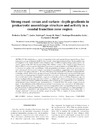Identificador persistente para citar o vincular este elemento:
https://accedacris.ulpgc.es/jspui/handle/10553/846
| Título: | Strong coast-ocean and surface-depth gradients in prokaryotic assemblage structure and activity in a coastal transition zone region | Autores/as: | Baltar González, Federico Arístegui, Javier Gasol, Josep M. Hernández-León, Santiago Herndl, Gerhard J. |
Clasificación UNESCO: | 251001 Oceanografía biológica | Palabras clave: | Procariotas Plancton Bacterias marinas |
Fecha de publicación: | 2007 | Publicación seriada: | Aquatic Microbial Ecology | Resumen: | The distribution of marine Crenarchaeota Group I, marine Euryarchaeota Group II and some major groups of Bacteria (SAR 11, Roseobacter, Gammaproteobacteria and Bacteroidetes) was investigated in the North Atlantic water column (surface to 2000 m depth) along a transect from the coastal waters of the NW African upwelling to the offshore waters of the Canary Coastal Transition Zone (CTZ). Catalyzed reporter deposition-fluorescence in situ hybridization (CARD-FISH) was used to describe the prokaryotic assemblages. Bulk picoplankton abundance and leucine incorporation were determined. Pronounced changes in prokaryotic assemblage composition were observed from the coast to the open ocean and at the deep chlorophyll maximum (DCM) with decreasing bulk heterotrophic activity. All bacterial groups decreased in absolute abundances from the coast to the open ocean; both archaeal groups increased towards the open ocean. Prokaryotic abundance and activity decreased 2 and 3 orders of magnitude, respectively, from the surface to 2000 m. Prokaryotic growth rates were high in the mesopelagic zone (~0.13 d–1), compared to other reports from the central North Atlantic. SAR11 in total picoplankton abundance decreased from 42% in the DCM to 4% at 2000 m, while marine Crenarchaeota Group I increased from 1% in the DCM to 39% in the oxygen minimum layer. A clear influence of the different intermediate water masses was observed on the bulk heterotrophic picoplankton activity, with lower leucine incorporation rates corresponding to layers where patches of Antarctic Intermediate Water were detected. Coast–ocean and surface–depth gradients in bulk prokaryotic abundance and production and assemblage composition were comparable to changes observed in basin-scale studies, pinpointing the CTZs as regions of strong variability in microbial diversity and metabolism. | URI: | https://accedacris.ulpgc.es/handle/10553/846 | ISSN: | 0948-3055 | DOI: | 10.3354/ame01156 | Fuente: | Aquatic Microbial Ecology[ISSN 0948-3055],v. 50, p. 63-74 |
| Colección: | Artículos |
Citas SCOPUSTM
46
actualizado el 08-jun-2025
Citas de WEB OF SCIENCETM
Citations
46
actualizado el 08-jun-2025
Visitas
147
actualizado el 22-feb-2025
Descargas
187
actualizado el 22-feb-2025
Google ScholarTM
Verifica
Altmetric
Comparte
Exporta metadatos
Los elementos en ULPGC accedaCRIS están protegidos por derechos de autor con todos los derechos reservados, a menos que se indique lo contrario.
